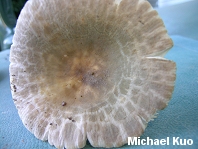| Major Groups > Gilled Mushrooms > Pale-Spored > Russula > Russula crustosa |

|
Russula crustosa [ Basidiomycetes > Russulales > Russulaceae > Russula . . . ] by Michael Kuo With its quilted cap, Russula crustosa looks like a pale, brownish yellow version of the green-capped Russula virescens. Close inspection, however, usually reveals a few differences beyond the color of the cap: the patchwork areas of Russula crustosa have sharper edges and are more clearly delineated than those of Russula virescens; there are usually more pleurocystidia in Russula crustosa (in Russula virescens they are scarce or absent); and the tips of the terminal cells in the pileipellis are generally more rounded in Russula crustosa. Description: Ecology: Mycorrhizal with oaks and perhaps with other hardwoods; growing alone, scattered, or gregariously; summer; widely distributed east of the Rocky Mountains. Cap: 5-10 cm; round to convex when young, becoming broadly convex to flat or uplifted, with a shallow depression; dry; soon cracking up into clearly defined patches that have fairly abrupt edges; buff, yellowish brown or faintly olive; the margin lined at maturity; the "skin" peeling about halfway to the center. Gills: Attached to the stem; close or crowded; some forking; white to creamy. Stem: 3.5-9 cm long; 1.5-3 cm thick; white; dry; smooth. Flesh: White; brittle; thick. Odor and Taste: Odor not distinctive; taste mild. Chemical Reactions: KOH on cap surface negative. Iron salts on stem surface negative or pink (sometimes slowly and/or faintly). Spore Print: White to creamy. Microscopic Features: Spores 6-9 x 5.5-7 µ; elliptical to nearly round; warts extending to about 0.5 µ high; connectors scattered and rare, usually not forming reticula. Pleurocystidia scattered to abundant; mucronate with a lengthened or subglobose extension. Pileipellis a cutis beneath an epithelium-like layer (the patches) of erect, chained elements, with the terminal cell featuring a blunt to somewhat elongated projection with a rounded (only rarely subacute) apex; pileocystidia very long, arising in the cutis, positive in sulphovanillin and refractive-ochraceous in KOH. REFERENCES: Peck, 1902. (Saccardo, 1891; Burlingham, 1915; Beardslee, 1918; Kauffman, 1918; Kibby & Fatto, 1990; Phillips, 1991/2005; Lincoff, 1992; Barron, 1999; McNeil, 2006; Buyck, 2007; Binion et al., 2008.) Herb. Kuo 06249503, 06220401, 07150702, 06240802. This site contains no information about the edibility or toxicity of mushrooms. |
© MushroomExpert.Com |
|
Cite this page as: Kuo, M. (2009, March). Russula crustosa. Retrieved from the MushroomExpert.Com Web site: http://www.mushroomexpert.com/russula_crustosa.html |






